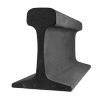From 1947-1961, the Milwaukee Road Olympian Hiawatha ran passenger excursions between Chicago and the Pacific Northwest, operated by the Chicago, Milwaukee, and St. Paul and Pacific Railroad.
The Olympian Hiawatha took scheduled excursions through scenic Idaho, Montanas Bitterroot Mountains, and Washingtons Cascade range. On June 29, 1947, the Milwaukee Road inaugurated its streamlined flagship on a 43-hour, 30-minute schedule. This was advertised as being a speedliner. The railroad contracted industrial designer Brooks Stevens to design the train consist, which included some unique and signature cars of the Milwaukee Road.
In 1952, the first full-length Super Dome cars were added, which included 68 dome seats and 28 lounge seats. The dome area featured seats positioned lengthwise, facing the 625 square foot double-pane windows. Ideal for insulation, and sightseeing.
In 1955, the Milwaukee Road announced that they would operate Union Pacific streamliners between Chicago and Omaha. This meant that the Hiawatha would be painted in Union Pacific’s Armour Yellow colors. In 1956, the line was officially “partnered with Union Pacific” as they navigated the next couple years competing with both airline and automobile travel. The Hiawatha train wore the UP colors into the sunset as The Afternoon Hiawatha ran up until January 23, 1970. The next year, The Morning Hiawatha service was also discontinued and replaced by Amtrak lines.
The Milwaukee Road used a total of three different locomotives to pull the consist between Chicago and Olympia, WA in the early 50’s – two electrics (used on electrified portions of the journey) and the EMD FP7 – a specialized variation of the F7A which was lenghtened to accomodate a larger water resevoir for its steam generators (a necessity for long distance passenger service like that of the Olympian Hiawatha). While E units could also have filled this role (and did, in later years), their A1A truck design (spreading their weight and giving them less traction) made them less than ideal for handling the steep grades of the Milwaukee’s route through the Rocky Mountains.





